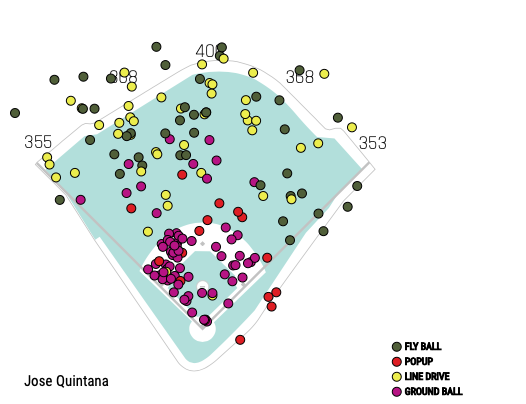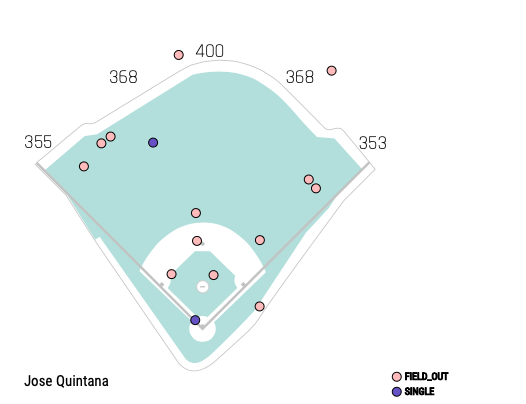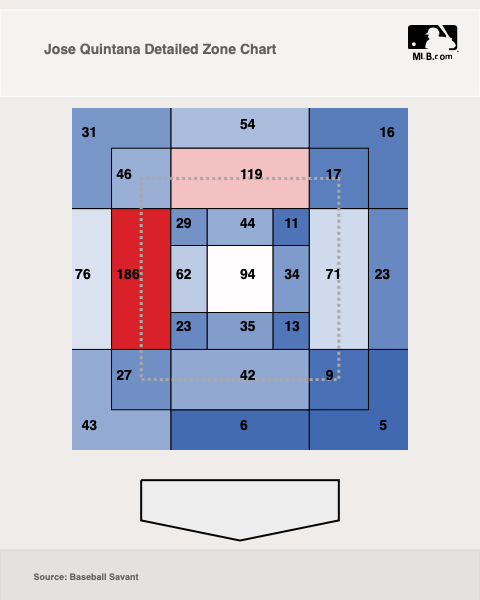With Dylan Cease making his major league career start recently and Eloy Jimenez lighting up the southside of Chicago, Cubs fans and fantasy owners might be upset with Theo Epstein trading them for José Quintana. I hear you guys. Quintana has been quite awful in his most recent starts. Is this just a bump in the road or is this what Quintana is from now on. Let’s take a deeper look and see what is going on.
Moving on the Rubber
During the first half of the 2018 season and his first full season as a Cub, Quintana was not the Quintana of old. He was walking batters at a 10.7% clip which was 3 percentage points higher than any point of his career. Add the walk issue with a downturn in his K% and career high in HR/9, his season was looking bleak. However, 2019 took a turn for the better when he took a turn to the left, the left side of the rubber that is.
Take a look at some video from early 2018 and later 2018.
https://gfycat.com/verifiablefancydutchshepherddog
https://gfycat.com/halffocusedkitty
Once you see it, you cannot un-see it. So what did this change do? Well, walks decreased, especially against right-handed batters. Before July 1st, righties were hitting .253 and he had an awful 1.51 WHIP. After he moved on the rubber, walks decreased back to career average 8.3% and batters were hitting only .239. Also, the contact righties were getting was quite poor. Take a look at pre-adjustment.
The average exit velocity from these pitches was 89.7 MPH.
After the adjustment, the exit velocity dropped to 87.0 MPH.
You can see he was attacking more inside to righties and was able to get poor contact on the wrists.
So what about this year. Well, Quintana has not been able to get on the hands of righties like he did late last year. Also, the exit velocity on these pitches increased back to 89.4 MPH.
Getting Beat by the Shift
Another interesting finding while doing this deep dive is the Cubs are shifting more when Quintana is on the mound. Last year, the Cubs shifted 2.4% and 4.3% against righties and lefties, respectively. This year, the Cubs defenders are shifting 8.2% and 16.2% against righties and lefties, respectively. What is interesting about this is that Quintana is actually being killed by the shift. Batters are hitting .333 when the infield is shifted, up from .211 last year.
It seems backward that the shift would seem to be hurting Quintana. Strangely enough, batted balls have the same launch angle of 18.7 degrees. However, the exit velocity on these batted balls increased from 82.9 MPH to 89.0 MPH.
Four-Seam Fastball
Last year, Quintana was four-seam fastball heavy; using the pitch close to 50% of the time. It made sense at the time, as it was an excellent pitch back in 2017. He had a 24.7 K% with a 6.6 BB% with the pitch. However, it massively regressed in 2018 and has actually gotten worse this year. He has lost spin on the pitch every single year he has been in the majors.
The league average spin rate on a four-seam fastball is 2,284 RPM. Quintana’s average spin rate this year is 1,999 RPM. Quintana also seems to not be locating his four-seamer ideally. Back in 2017, he was coming in to right-handed batters.
Take a look at his pitch location this year.
He is still coming inside but he is also missing arm side. It is easy to see why batters are feasting on the pitch. They are hitting .302, with an xBA of .293, and SLG of .444, with an xSLG of .457. Batters are also making less than ideal contact, for a pitcher that is. Take a look at the 2017 spray chart.
 He was getting batters to hit groundballs to the left side of the diamond. This is what you want to see if you have Javy Baez and to a lesser extent, Kris Bryant playing at short and third. Now take a look at this year’s spray chart.
He was getting batters to hit groundballs to the left side of the diamond. This is what you want to see if you have Javy Baez and to a lesser extent, Kris Bryant playing at short and third. Now take a look at this year’s spray chart.
No more grounders and a bunch more line drives. He is giving up line drives 34.9% of the time, which is the highest of his career. Keep in mind, it is just now starting to get warm in Chicago so I am afraid of what that warmer weather will be doing to this pitch.
Curveball
Quintana’s best pitch has always been his curveball. He moved away from the pitch last year but, thankfully, is throwing it 26% of the time now. It is the pitch that has always gotten the most players to chase, has it has an O-Swing% hovering around 30%. So far this season, the curve is getting batters to swing outside the zone 34.6%. For some reason, Quintana has been using his sinker far more against lefties instead of this wicked curve and I am not sure why. The curve has 40 K%, xBA of .204, and xSLG of .245. Take a look at the difference in wOBA between the curve and sinker against lefties.
For him, I really hope he starts using the pitch more in the second half of the year.
Sinker
I’m not a fan of the sinker pitch. To me, it is not the type of pitch that pitchers can get away with it in today’s elevate to celebrate baseball. Quintana has been throwing the pitch more this year. He is throwing it 33.6% of the time and the zone% percentage has increased from 52.1% to 57.2%. He has been pounding the zone with the sinker and batters have been pounding the pitch all over the park.
The average exit velocity of 90.4 MPH and the average launch angle of 8 degrees is not a recipe for success.
What should Fantasy Owners do?
I am sorry everyone. The more and more I took a look at Quintana’s season, the more I was scared off. His pitches overall have been less effective. He is generating constant hard contact. If I had a chance to move on from him, I would. He is what Nick likes to call a Toby and on the lower end of that tier. The old reliable Quintana from a couple of years ago is gone. His 2-Stk% is 24.24% with a 2-Stk SwStk% of 11.62%, which places him around Mike Foltynewicz and teammate Jon Lester. Not exactly a great group of guys to be around.
Featured image by Justin Paradis (@freshmeatcomm on Twitter)














I have quickly become a fan of your work. Keep it up!